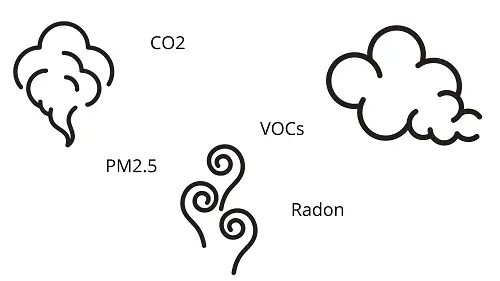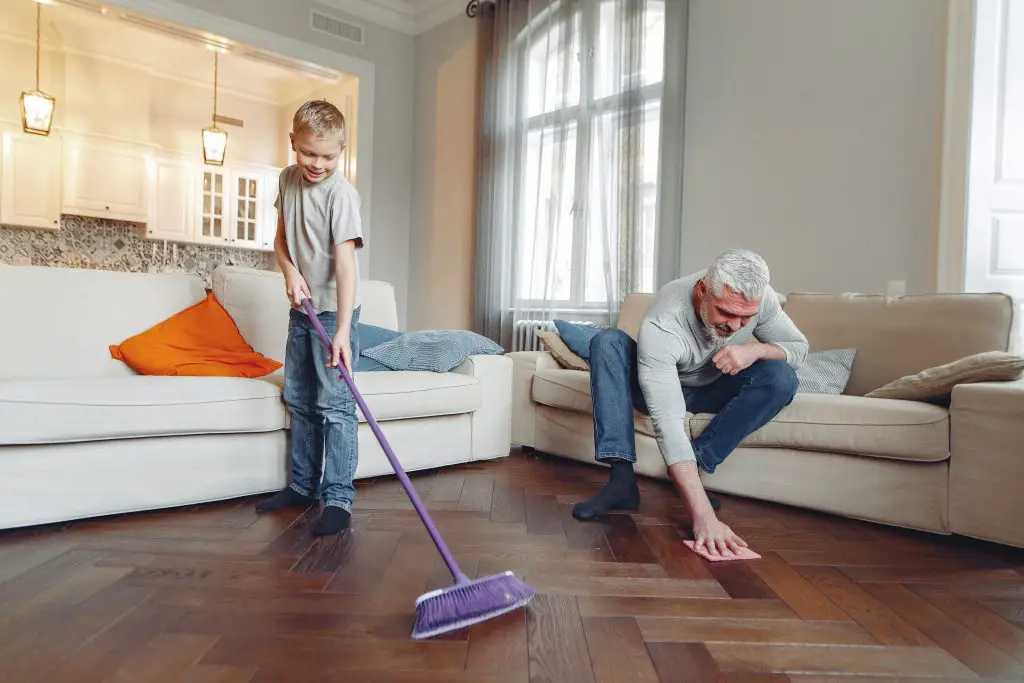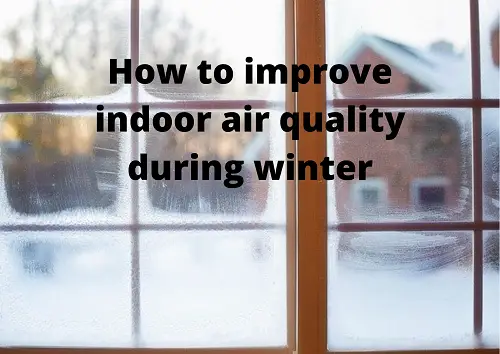During winter, the best way to improve your air quality is to reduce the release of pollutants. Other options are to run your extractor hood on full speed, clean and vacuum more often, air out the house, and use an air purifier or air quality monitor.

Indoor air quality is generally worse during the winter. This has several causes, including natural causes and our own habits.
- Colder and drier air is more stale and traps pollutants
- We tend to ventilate and air out the house less often
- We use more fuel-burning heaters such as a fireplace, which creates air pollutants
On top of that, we tend to spend even more time indoors during the winter. On average, people spend about 90% of their time indoors, according to the US Environment Protection Agency. Indoor air quality is on average 2 to 5 times worse than outdoor air quality (source). Therefore, it is a good idea to see how to improve our indoor air during the winter season.
Poor indoor air quality is caused by many different factors. Among those are:
- Cooking
- Fuel burning (for heating)
- cleaning products
- paints, resins, and glues
- burning candles
- (outdoor) car exhaust coming in
If you would like to know more about how your indoor air gets polluted, I recommend reading my article: This is what causes your poor indoor air.

How to reduce air pollutants during the winter
Your best options for improving air quality during the winter are:
- reduce the release of air pollutants
- run your extractor hood on full speed
- ensure good ventilation
- air out the house once in a while
- clean and vacuum more often
- run an air purifier
- use an air quality monitor
How to reduce the release of air pollutants
Many indoor air pollutants are released by our own actions. Therefore, the best way to improve your indoor air quality is not to pollute it in the first place.
As I listed above, cooking, fire, paints, and cleaning products are among the main causes of indoor air pollution. All of these are caused by our own activities. This means we can change some of our habits to improve the air.
Fuels, candles, and cooking each cause emissions of CO2, carbon monoxide (CO), and particulate matter (fine dust). Eliminating the burning of candles is an easy fix. However, not burning fuels is more difficult, and not cooking is not an option.
For the burning of fuels, the creation of air pollutants greatly depends on the type of heater and fuel that you are using. A fireplace burning wood, for example, causes a lot of particulate matter. Especially when you have an open fireplace instead of a wood stove. Burning oil or gas is a much cleaner burning process. Therefore, the release of pollutants is much lower. (incomplete burning causes the most particles to be released)
If you are concerned about your heater creating air pollutants, consider purchasing a newer, modern model. Another option is to make sure it is well maintained and cleaned. However, your best option is to look for a different heater that emits less to no pollutants.
One of the topics on this website is infrared heating. This form of heating does not burn any fuel but runs on electricity. If you are interested, I recommend reading my article: The pros and cons of infrared heating. Another option is to look at a heat pump. I also wrote a pros and cons article on heat pumps.
How to reduce air pollutants from cooking
Since we cannot stop cooking, we need to find other ways to reduce the emissions of air pollutants during the preparation of food. Our options are: run the extractor hood on full speed, use a pit at the back of the stove, reduce the use of oil, and change to an electric stove instead of gas.
One of the best ways to reduce emissions from cooking from entering our air is to make sure the extractor hood is running at full speed. This makes sure any gases and particles are immediately extracted. On top of that, it is best to use one of the pits that are at the back of the stove. In this way, the extractor hood can work more effectively.
If you cook with a lot of cooking oil, you will know that your extractor hood will get really dirty from it. This is clearly a sign that the oil, when heated, enters the air. When you are running the extractor hood, some of the airborne oil gets stuck in the grill. However, part of these airborne oil particles will get into your air and reduce the air quality. Therefore, I recommend trying to use less oil or other fats when cooking.
Another source of air pollutants when cooking is the fire from a gas stove. Fire always causes some particulate matter, carbon monoxide, and CO2. To reduce these emissions, consider switching to an electric stove.
I personally like to use an instant pot. An instant pot does not produce any emissions. On top of that, it is very energy efficient since it’s very well insulated. Check out the instant pot I use here on amazon.com.
How to ventilate without heat loss
Ventilating without heat loss is almost impossible with the exception of heat recovery ventilation systems. These systems work with a heat exchanger. A heat exchanger takes up (some) warmth from the outgoing indoor air and gives it back to the incoming fresh air.
If you are considering improving or replacing your ventilation system or vents, you should consider heat-recovery ventilation. You can read all about heat-recovery ventilation in my article here.
Another simpler option is to open more doors between rooms in the house. In this way, you will not truly introduce fresh air. However, if your main activities are, for example, in the kitchen, you can dilute this air by mixing it with the air in other rooms. In this way, the air pollutants will spread over a larger volume of air. Because of this, the average concentration of the pollutants will decrease.
For many indoor air pollutants, this is an oke strategy because low levels are not harmful. For example, if CO2 levels are a bit high in one room, exchanging air with other room can lower it to normal, safe levels.
Cleaning and vacuuming to improve air quality
One of the main air pollutants, fine dust (particulate matter), tends to settle down on the ground and furniture. This gives us the opportunity to simply vacuum them away. This prevents fine dust from re-entering the air when people move around.
Dust particles in the air are more often a problem during the winter compared to other seasons. During winter, we use our heating system more often. This leads to the heating of air, which causes increased airflow because warm air rises. Air circulation throughout the room increases the occurrence of settled down particles to become airborne again. Combined with decreased ventilation to keep in the heat, fine dust is of special concern during winter.
Surprisingly, cleaning products are a source of air pollutants. Many non-natural cleaning products do emit volatile organic compounds (VOCs) when used or improperly stored. Therefore, make sure to use natural cleaning products, and do not mix them. Additinally, make sure to store them well. Clean the outside of the bottles, make sure the lid is properly closed, and store them in a well closed area.

Run an air purifier to clean the air
Although ventilation is the single best way to improve indoor air quality, air purifiers are a great alternative or supplement. Ventilation is the best option because it deals with all air pollutants and does not require a device or energy use.
Air purifiers can be of great help in improving your air. Most air purifiers are equipped to remove particles from the air. However, some purifiers can also remove VOCs. Air purifiers work less well when there is a lot of ventilation. In winter, however, they are the perfect solution when you decrease your ventilation.
If you are interested in air purifiers, I recommend reading my article: How to know if you need an air purifier (+what it does and doesn’t do)
Using an air quality monitor to improve air quality
Unlike an air purifier, an air quality monitor does not improve the air by itself. It can however, detect which and how much air pollution is present. Since air purifiers can only remove a few compounds and ventilation is your best option, I personally prefer using a monitor.
An air quality monitor really helps in detecting what pollutants you have an when they occur. With this information, you can take action to improve your air. You can, for example, try to eliminate the source or start airing out the house at the perfect time.

Get a 10% discount on Airthings air quality monitors
I managed to arrange a discount for people reading my website! By using this link to the Airthings wave Mini air quality monitor, you will get a 10% discount. Use my personalized coupon code at checkout to get 10% off: 665381-10OFF. The Airthings Wave Mini is a small battery-operated device that measures total VOCs, temperature, and humidity levels.
If you are willing to spend a bit more to be absolutely sure about your indoor air quality, the Airthings Wave Plus is an excellent option. This air quality monitor not only measures VOCs, humidity, and temperature but also CO2 levels, air pressure, and radon. Just like the Wave Mini, it comes with an app that shows your latest data. By using this link to the Airthings Wave Plus air quality monitor you will get a discount of about 10% when you use my coupon code mentioned above.
Don’t let yourself get tricked by ‘natural air cleaning’ claims
If you google for natural ways to clean the air, you will get all kinds of alternative ‘natural’ methods for cleaning the air. Please don’t let yourself get fooled. Houseplants really do not help unless you have hundreds of them. I wrote an article on what houseplants actually do and why most houseplant claims are fake news: Do house plants improve indoor air quality? (surprising results)
Other than houseplants, there are many products that claim to improve your air quality. For example, beeswax candles (they are simply a little less bad than regular candles), or a Himalayan salt lamp (does not do anything). You can read my article about these and many more ‘natural purifiers’ here: How to naturally purify the air in your house, a critical review.


